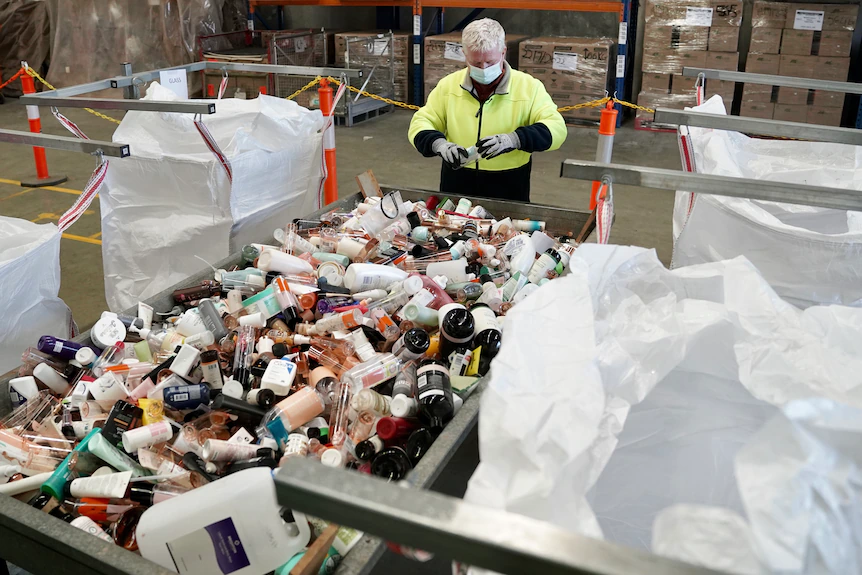- Home
- News
- Can you recycle old cosmetic packaging? Here’s what’s happening in an $8 billion industry that generates a lot of waste
Can you recycle old cosmetic packaging? Here’s what’s happening in an $8 billion industry that generates a lot of waste
Australians spend billions of dollars a year on beauty products, but most of the remaining packaging ends up in landfills.
It is estimated that more than 10,000 tonnes of cosmetic waste in Australia ends up in landfill each year, as cosmetic products are not usually recycled by the roadside.
This is because they are too small to be sorted in conventional facilities and often contain complex and mixed materials and residual products, which make them difficult to recycle along with ordinary glass and plastic.
So what should you do with your old makeup and perfume?
What is the company doing?
A growing number of Australian and international beauty brands and retailers now offer take-back programs where you can return used beauty products in-store for recycling.
These products, including skin cream tubes, plastic and metal eyeshadow trays, foundation and perfume bottles, are sorted into different waste streams such as glass, metal, soft and hard plastics.
They are then sent for processing to be transformed into other products.
The end result of the waste depends on the company doing the recycling and the material of the packaging.
Australian recycling company Close the Loop converts plastics into asphalt additives for roads.
Some rigid plastics can be shredded and used as concrete additives, while glass can be shredded and used as a sand substitute for buildings in the construction industry, it said.
Other companies, such as TerraCycle, say their recycled plastic waste can be used in garden beds, outdoor playgrounds and fencing.
Who is doing recycling?
At this stage, private companies, not local councils, are responsible for recycling in the beauty and cosmetics industry.
Close the Loop recently announced a makeup collection trial with retail giant Myer, where consumers have until mid-September to bring back any used makeup to participating stores.
MAC Cosmetics is also part of the trial, which will help investigate the viability of a national beauty recycling program.
The closed-loop trial was funded by a $1 million grant from the federal government.
A spokesman for the federal environment ministry said it was funding the trial because cosmetics are difficult to recycle “through the normal process”.
“The project will establish a cosmetic recycling scheme by creating an integrated collection network that will collect, process and recycle waste from cosmetic products,” the spokesperson said.
Play or pause space, M to mute, left and right arrows to search, up and down arrows volume.
Major beauty retailers such as Mecca, David Jones, Jurlique, Olay, Sukin and Schwarzkopf are also running payback programmes, partnering with international firm TerraCycle.
Jean Bailliard is the CEO of TerraCycle Australia/NZ, which recently partnered with French multinational Sephora.
“We have partnerships with brands and retailers like Sephora to pay for collection and recycling,” he said.
That means brands pay the bill.
“We don’t rely on the value of plastic to cover our costs,” he said.
“We get funding from industries that want to do the right thing.”
Jennie Downes, a research fellow at Monash University’s Institute for Sustainability, said it was still early days to recycle cosmetics and not yet economically viable.
“[The new] recycling scheme will have a hard time competing with the huge amount of plastic that is currently being produced and put on the market,” she said.
She said there was also a question of whether there was enough demand for recycled products, a challenge not only for the beauty industry but for recycling across Australia.
What can’t be recycled?
Different plans have different rules, so it’s best to check with where you returned the packaging to see what they can bring.
Generally, recycling programs can take things like hand or body cream, eye shadow, eyeliner, mascara, or any other hair or skin care product.
They have a hard time accepting aerosols and nail polishes made of complex materials, and they can also be flammable.
TerraCycle and its partner brands do not accept aerosols or nail polishes because it says they are difficult to ship by post.
TerraCycle also says it can only recycle empty packaging.
The government-funded Myer trial with Close The Loop is testing acceptance of products like aerosols and nail polish to see if they can find a way to transport and recycle them safely.
The trial will also accept packaging with leftover product, although most take-back programs require returned product to be empty.
How do I know if a product has actually been recycled?
It’s a tricky one, but researcher Jenni Downes says it’s best to trust that companies are doing the right thing and get in the habit of trying to recycle products you might have previously thrown in the bin.
“There’s definitely some skepticism and mistrust that businesses may be greenwashing,” she said.
“I think this kind of information does increase trust in how much was returned, what became, whether it happened locally or overseas.”
In terms of the amount of recycled products or the type of things they turn into, the numbers are likely to be small at first, Ms Downes said.
“It’s okay because they’re new,” she said.
“But they can tell the story and publish the data…because if they don’t share that information, it’s hard for customers to trust them.”
Another thing to consider is switching to refillable products, which are gaining popularity in the market, she said.
“Recycling is definitely the last line of defense, and from a hierarchy, reuse and refillable packaging is also good,” she said.
Call us today at +86 18692024417 or email info@topfeelgroup.com
Please tell us your inquiry with details and we will get back to you as soon as possible. Due to time difference, sometimes the response may be delay, please wait patiently. If you have an urgent need, please call to +86 18692024417
